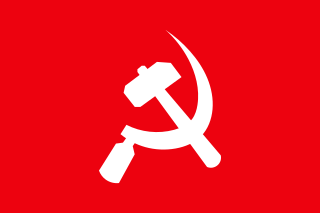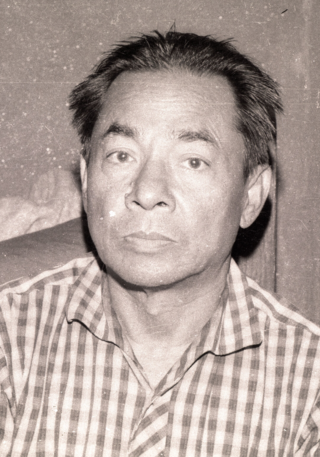
The Communist Party of Nepal, abbreviated CPN, was a communist party in Nepal from 1949 to 1962. It was founded on 15 September 1949 to struggle against the autocratic Rana regime, feudalism, and imperialism. The founding general secretary was Pushpa Lal Shrestha. The founding members of the Communist Party of Nepal were Moti Devi Shrestha, Niranjan Govinda Vaidya, Nar Bahadur Karmacharya and Narayan Bilas Joshi.

The Communist Party of Nepal (Unified Marxist–Leninist) (Nepali: नेपाल कम्युनिष्ट पार्टी (एकीकृत मार्क्सवादी-लेनिनवादी), romanized: nēpāl kamyuniṣṭ pārṭī (ēkīkṛt mārksavādī-lēninavādī); abbr. CPN (UML)) is a communist political party in Nepal. The party emerged as one of the major parties in Nepal after the end of the Panchayat era.

The Communist Party of Nepal (Fourth Convention) (Nepali: नेपाल कम्युनिष्ट पार्टी (चौथो महाधिवेशन), Nepala Kamyunishta Parti (Chautho Mahadhiveshan)) was a communist party in Nepal 1974–1990. It was the major communist group in Nepal during the latter part of the 1970s, but gradually lost influence due to internal disputes. The party actively participated in the struggle for democracy in 1990, and its leader took part in writing the Nepalese Constitution. It later merged with other forces to form the Communist Party of Nepal (Unity Centre), out of which the Communist Party of Nepal emerged.

The Communist Party of Nepal (Pushpa Lal) was a communist splinter group led by Pushpa Lal Shrestha. The party emerged in 1968, as Pushpa Lal organized a separate party congress in Gorakhpur, India.

The Communist Party of Nepal (Manmohan) was a communist party in Nepal led by Man Mohan Adhikari, an erstwhile leader of the radical faction of the Communist Party of Nepal (CPN) who had taken part in organising the Central Nucleus (an attempt to rebuild the CPN). Since the breakup of the Central Nucleus in 1973, he had led his own group of followers but it was not until 1979 that they constituted themselves as a separate party. Until 1982, the party was known as the Communist Party of Nepal (Unity Conference).

The Communist Party of Nepal (Marxist) was a political party in Nepal. It was formed through the merger of the Communist Party of Nepal (Manmohan) led by Man Mohan Adhikari and the Communist Party of Nepal (Pushpa Lal) led by Sahana Pradhan in 1987. The Nepal Trade Union Centre was the trade union of CPN (Marxist) and Nepal Progressive Students Union was their students' union.

The Communist Party of Nepal (Mashal) was an underground communist party in Nepal. CPN (Mashal) was formed in November 1984, following a split in the Communist Party of Nepal (Masal). The new party was founded at a congress (labelled the 'fifth congress') in Gorakhpur, India. It was difficult to identify any major ideological difference between the two factions, and probably the split was caused by dissatisfaction with Singh's authoritarian leadership methods. Mohan Baidya (alias 'Kiran') became general secretary of the new party. Other Central Committee members elected at the Gorakhpur conference were Chitra Bahadur K.C., Ramsingh Shris, Bhairav Regmi, Govindsingh Thapa, Pushpa Kamal Dahal, Khambasingh Kubar, Bachaspati Devkota, C.P. Gajurel, Dev Gurung, Ishwari Dahal, Bishnu Pokhrel and Bhakta Bahadur Shrestha.

The Communist Party of Nepal (Marxist–Leninist) was a political party in Nepal. It was launched in 1978 by the All Nepal Communist Revolutionary Coordination Committee (Marxist–Leninist), which was founded by groups involved in the Jhapa movement. The CPN (ML) published Varg-Sangarsh and Mukti Morcha.

Communist Party of Nepal (Burma) (Nepali: नेपाल कम्युनिष्ट पार्टी (वर्मा)), initially known simply as Communist Party of Nepal or Communist Party of Nepal (Rayamajhi Group), was a communist party in Nepal. The party emerged from a split in the original Communist Party of Nepal in 1962, representing the pro-Soviet sector of the party. Its main leader until 1983 was Keshar Jung Rayamajhi, who had been the general secretary of the original CPN.

Mohan Bikram Singh, often referred to as MBS, party name Gharti, is a Nepalese communist politician. His father was a wealthy landlord in Pyuthan District who was close to King Tribhuvan. MBS however joined the opposition Nepali Congress in 1950, and took part in the 1950–1951 uprising for democracy.

Pushpa Lal Shrestha was a Nepali politician, considered to be the father of Nepali communism. He was the founding general secretary of the Communist Party of Nepal.

The Nepal Communist Party, abbreviated NCP is a defunct communist party which existed in Nepal from 2018 to 2021. It was founded on 17 May 2018, from the unification of two leftist parties, Communist Party of Nepal and Communist Party of Nepal. The unification was completed by the Party Unification Coordination Committee, after eight months of negotiation. The two predecessor parties subsequently dissolved, making way for the new united party. The party retained the electoral symbol of the CPN (UML), the sun.

Sahana Pradhan was a Nepalese politician from a Newar family in Kathmandu. She resigned as Minister of Foreign Affairs of Nepal on April 16, 2008. She also served as Deputy Prime Minister of Nepal within the coalition government of Prime Minister Girija Prasad Koirala from 2007 to 2008.

Keshar Jung Rayamajhi was a Nepalese politician. He was a leading figure in the communist movement in the country, but later turned into a royalist. Rayamajhi hails from a landlord Chhetri family in Tansen, Palpa district.
The Communist Unity Contact Forum Nepal was a Nepalese communist organisation. It was founded in July 1974 by communists who had developed differences with the Communist Party of Nepal. The group was based in western Nepal and in exile in India. The organisation published Rato Jhanda. The ideology of the group was Marxism–Leninism-Mao Zedong Thought, and it worked for the creation of a militant and well-organised communist party. The group accused Manmohan Adhikari, Pushpa Lal Shrestha and Mohan Bikram Singh for factionalism.
The Communist Party of Nepal was founded in Calcutta, India, on 15 September 1949.

Communism in Nepal traces its roots back to the pro-democracy movement of 1951, and the subsequent overthrow of the autocratic Rana regime and the establishment of democracy in Nepal. The communist movement in Nepal has split into factions multiple times and multiple factions have come together into a single fold at times as well. It has a history of getting banned from open political discourse, as well as multiple instances of embracing guerrilla insurgency, most notably, the Maoist insurgency in the 1990s and early 2000s that led to the Nepalese Civil War, claiming at least 17,000 lives.

General elections were held in Nepal on 20 November 2022 to elect the 275 members of the House of Representatives. There were two ballots in the election; one to elect 165 members from single-member constituencies via FPTP, and the other to elect the remaining 110 members from a single nation-wide constituency via party-list proportional representation.

Tulsi Lal Amatya was a Nepalese politician.

At the end of 2020, a major split in the Nepal Communist Party (NCP) revived the Communist Party of Nepal and the Communist Party of Nepal.








